Applying Deming's 14 Points and McGregor's Theory X & Y to Education
VerifiedAdded on 2023/05/30
|8
|1669
|488
Essay
AI Summary
This essay provides a comparative analysis of Deming’s 14 Points and McGregor’s Theory X and Theory Y, exploring their relevance and application within educational institutions. It highlights Deming's emphasis on long-term planning, continuous improvement, and quality, contrasting it with Theory X and Y's focus on employee motivation and management styles. The essay argues that while Deming's approach emphasizes top-down management and long-term vision, McGregor's theory prioritizes employee involvement and positive management styles. It suggests that a balanced approach, incorporating elements from both theories, is crucial for effective educational management, emphasizing the importance of innovation, quality, and employee development to achieve long-term sustainability and success. Desklib offers this and many other solved assignments for students.
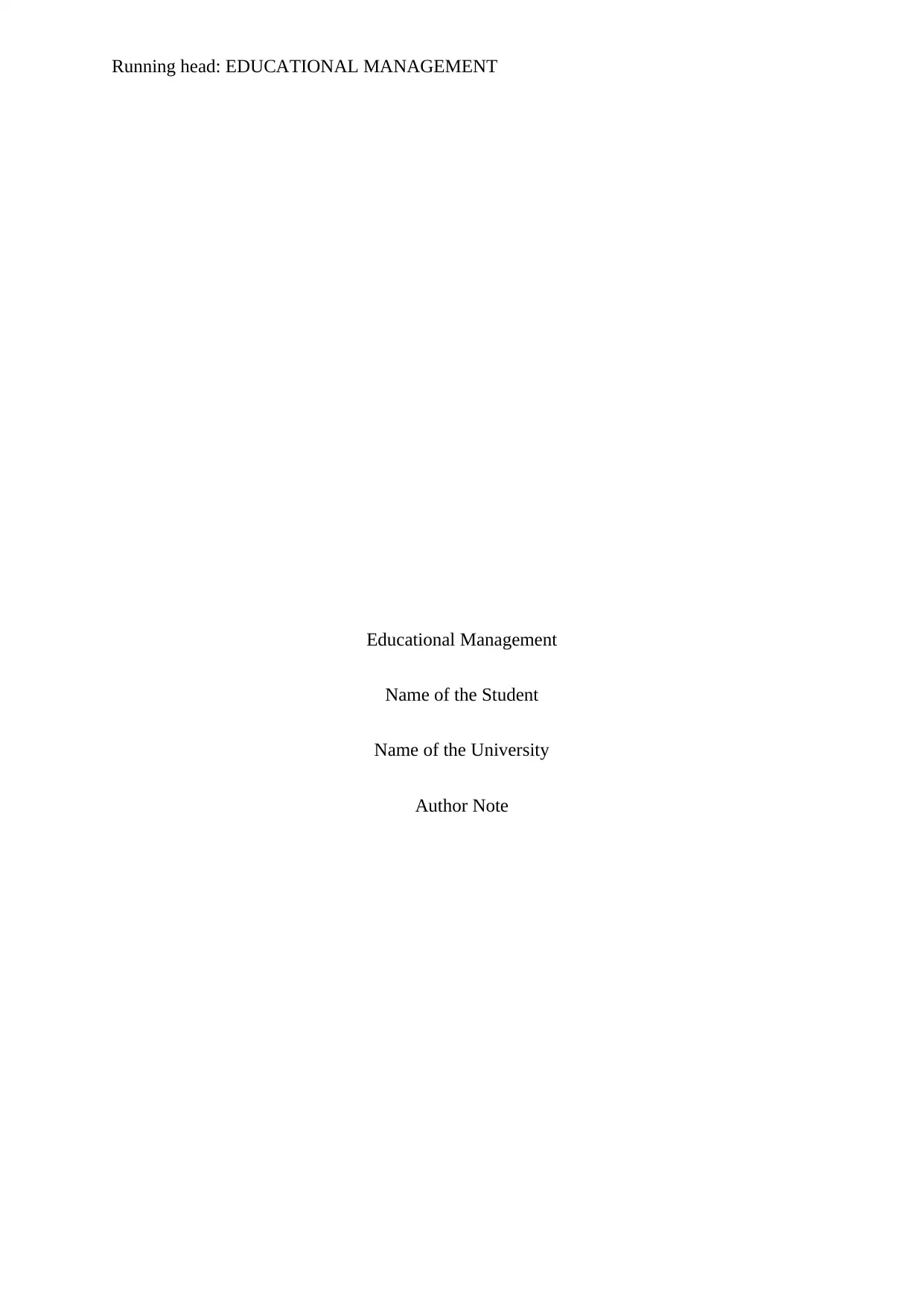
Running head: EDUCATIONAL MANAGEMENT
Educational Management
Name of the Student
Name of the University
Author Note
Educational Management
Name of the Student
Name of the University
Author Note
Paraphrase This Document
Need a fresh take? Get an instant paraphrase of this document with our AI Paraphraser
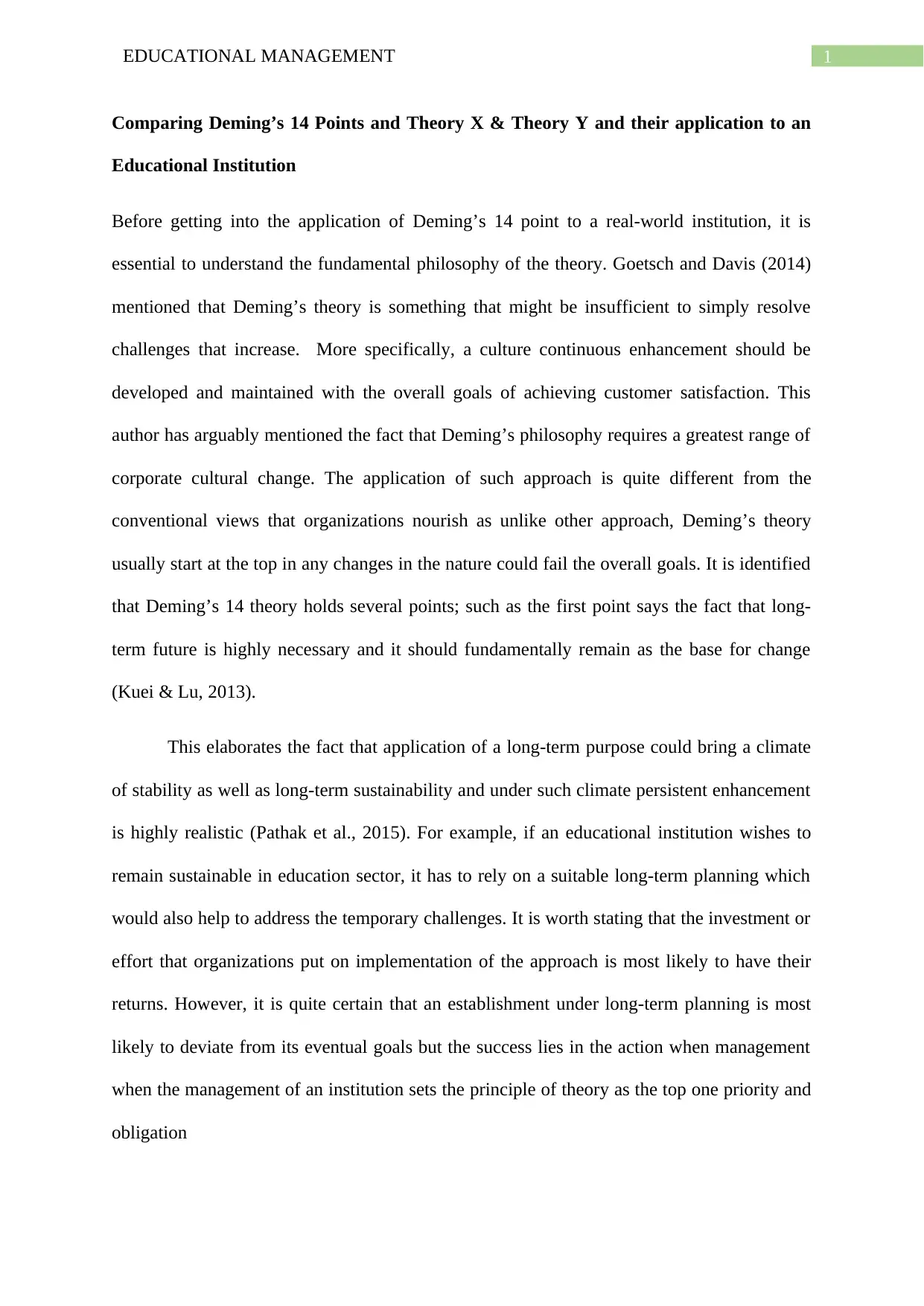
1EDUCATIONAL MANAGEMENT
Comparing Deming’s 14 Points and Theory X & Theory Y and their application to an
Educational Institution
Before getting into the application of Deming’s 14 point to a real-world institution, it is
essential to understand the fundamental philosophy of the theory. Goetsch and Davis (2014)
mentioned that Deming’s theory is something that might be insufficient to simply resolve
challenges that increase. More specifically, a culture continuous enhancement should be
developed and maintained with the overall goals of achieving customer satisfaction. This
author has arguably mentioned the fact that Deming’s philosophy requires a greatest range of
corporate cultural change. The application of such approach is quite different from the
conventional views that organizations nourish as unlike other approach, Deming’s theory
usually start at the top in any changes in the nature could fail the overall goals. It is identified
that Deming’s 14 theory holds several points; such as the first point says the fact that long-
term future is highly necessary and it should fundamentally remain as the base for change
(Kuei & Lu, 2013).
This elaborates the fact that application of a long-term purpose could bring a climate
of stability as well as long-term sustainability and under such climate persistent enhancement
is highly realistic (Pathak et al., 2015). For example, if an educational institution wishes to
remain sustainable in education sector, it has to rely on a suitable long-term planning which
would also help to address the temporary challenges. It is worth stating that the investment or
effort that organizations put on implementation of the approach is most likely to have their
returns. However, it is quite certain that an establishment under long-term planning is most
likely to deviate from its eventual goals but the success lies in the action when management
when the management of an institution sets the principle of theory as the top one priority and
obligation
Comparing Deming’s 14 Points and Theory X & Theory Y and their application to an
Educational Institution
Before getting into the application of Deming’s 14 point to a real-world institution, it is
essential to understand the fundamental philosophy of the theory. Goetsch and Davis (2014)
mentioned that Deming’s theory is something that might be insufficient to simply resolve
challenges that increase. More specifically, a culture continuous enhancement should be
developed and maintained with the overall goals of achieving customer satisfaction. This
author has arguably mentioned the fact that Deming’s philosophy requires a greatest range of
corporate cultural change. The application of such approach is quite different from the
conventional views that organizations nourish as unlike other approach, Deming’s theory
usually start at the top in any changes in the nature could fail the overall goals. It is identified
that Deming’s 14 theory holds several points; such as the first point says the fact that long-
term future is highly necessary and it should fundamentally remain as the base for change
(Kuei & Lu, 2013).
This elaborates the fact that application of a long-term purpose could bring a climate
of stability as well as long-term sustainability and under such climate persistent enhancement
is highly realistic (Pathak et al., 2015). For example, if an educational institution wishes to
remain sustainable in education sector, it has to rely on a suitable long-term planning which
would also help to address the temporary challenges. It is worth stating that the investment or
effort that organizations put on implementation of the approach is most likely to have their
returns. However, it is quite certain that an establishment under long-term planning is most
likely to deviate from its eventual goals but the success lies in the action when management
when the management of an institution sets the principle of theory as the top one priority and
obligation

2EDUCATIONAL MANAGEMENT
Conversely, principle of McGregor theory X and Y prioritize the involvement of
people or the organization as a whole to achieve a long-term success and planning. Arslan
and Staub, (2013) mentioned that psychological interaction between the management of an
organization as well as subordinate employees are wide in nature. This means before going
into the implementation of a big initiative, the organization must have to take are of its
employees. It is certain that organization cannot its purpose without its people; thereby, to
enhance or achieve an improved performance for the business it has to strengthen its relation
with its employees. According to Mohamed and Nor (2013), the best way to take care of the
employees, is to find what motivates or please employees. Thus, to take this fact into
consideration, several theories have been formed but particularly theory X and Y deals with
the motivational elements revolving around employees’ behaviour towards the organization.
Theory X and Y is worth considering in an educational institution because its principles are
focussed on developing a positive management style. However, Pathak et al., (2015)
commented that Theory X may not be appropriate for development of an institution because
considering employees lazy for a particular job and penalize them for their consequence often
produces poor result.
Unlike, Deming’s 14 point theory, McGregor theory X and Y is not controlled from
the top; this means that managers and supervisors in the middle of a structure of hierarchy,
being inspired from managers put the workforce under strict vigil and especially in an
educational institution, holding the perspectives that employees dislike work or avoid
responsibility is barrier in deriving a desired result. To run a school or any form of
educational institution, employees’ involvement in each task should he prioritized and
development of such perspective should begin from the top management of the organization.
In order to operate or perform school activities, leaders should frequently interact with all
Conversely, principle of McGregor theory X and Y prioritize the involvement of
people or the organization as a whole to achieve a long-term success and planning. Arslan
and Staub, (2013) mentioned that psychological interaction between the management of an
organization as well as subordinate employees are wide in nature. This means before going
into the implementation of a big initiative, the organization must have to take are of its
employees. It is certain that organization cannot its purpose without its people; thereby, to
enhance or achieve an improved performance for the business it has to strengthen its relation
with its employees. According to Mohamed and Nor (2013), the best way to take care of the
employees, is to find what motivates or please employees. Thus, to take this fact into
consideration, several theories have been formed but particularly theory X and Y deals with
the motivational elements revolving around employees’ behaviour towards the organization.
Theory X and Y is worth considering in an educational institution because its principles are
focussed on developing a positive management style. However, Pathak et al., (2015)
commented that Theory X may not be appropriate for development of an institution because
considering employees lazy for a particular job and penalize them for their consequence often
produces poor result.
Unlike, Deming’s 14 point theory, McGregor theory X and Y is not controlled from
the top; this means that managers and supervisors in the middle of a structure of hierarchy,
being inspired from managers put the workforce under strict vigil and especially in an
educational institution, holding the perspectives that employees dislike work or avoid
responsibility is barrier in deriving a desired result. To run a school or any form of
educational institution, employees’ involvement in each task should he prioritized and
development of such perspective should begin from the top management of the organization.
In order to operate or perform school activities, leaders should frequently interact with all
⊘ This is a preview!⊘
Do you want full access?
Subscribe today to unlock all pages.

Trusted by 1+ million students worldwide
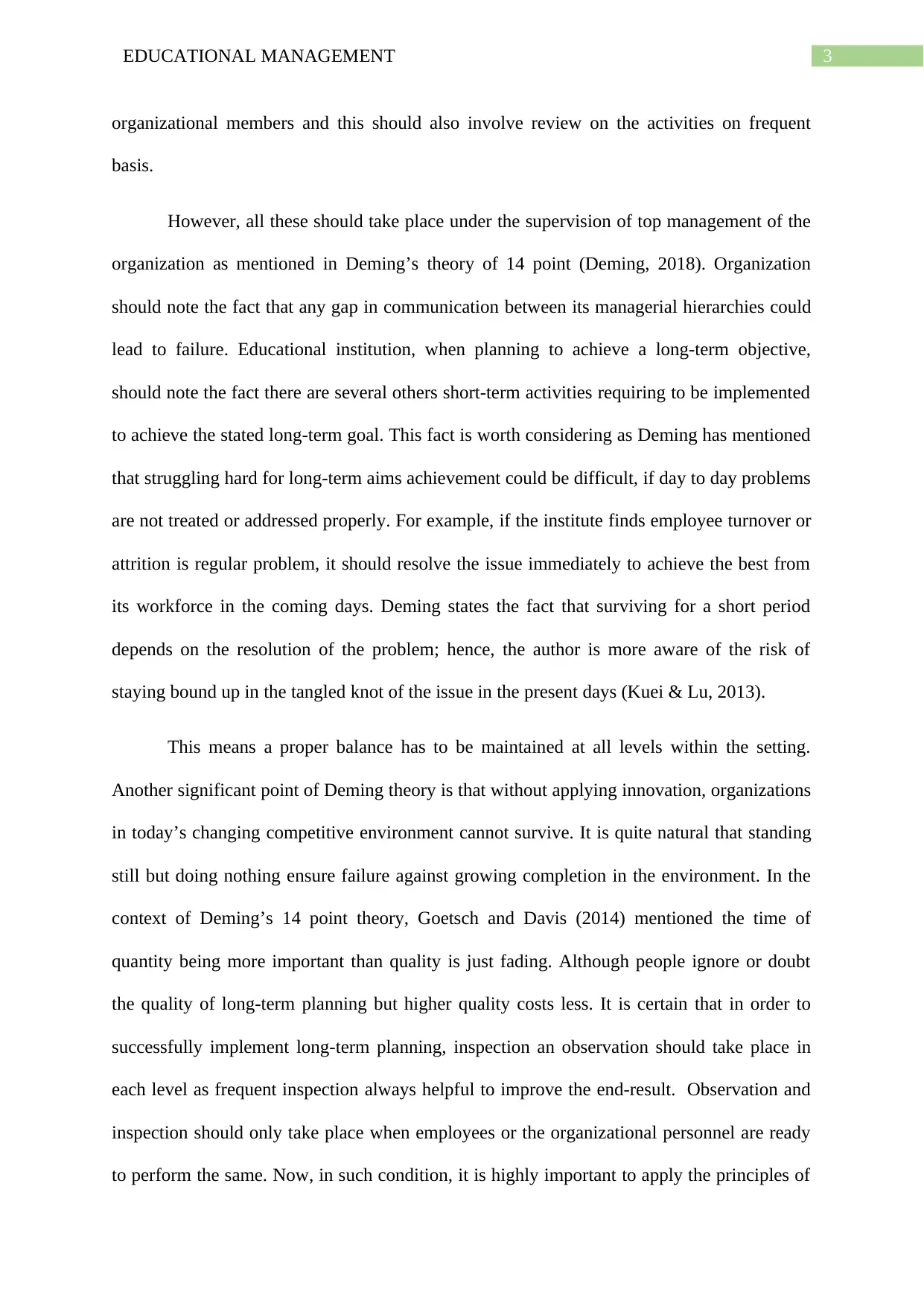
3EDUCATIONAL MANAGEMENT
organizational members and this should also involve review on the activities on frequent
basis.
However, all these should take place under the supervision of top management of the
organization as mentioned in Deming’s theory of 14 point (Deming, 2018). Organization
should note the fact that any gap in communication between its managerial hierarchies could
lead to failure. Educational institution, when planning to achieve a long-term objective,
should note the fact there are several others short-term activities requiring to be implemented
to achieve the stated long-term goal. This fact is worth considering as Deming has mentioned
that struggling hard for long-term aims achievement could be difficult, if day to day problems
are not treated or addressed properly. For example, if the institute finds employee turnover or
attrition is regular problem, it should resolve the issue immediately to achieve the best from
its workforce in the coming days. Deming states the fact that surviving for a short period
depends on the resolution of the problem; hence, the author is more aware of the risk of
staying bound up in the tangled knot of the issue in the present days (Kuei & Lu, 2013).
This means a proper balance has to be maintained at all levels within the setting.
Another significant point of Deming theory is that without applying innovation, organizations
in today’s changing competitive environment cannot survive. It is quite natural that standing
still but doing nothing ensure failure against growing completion in the environment. In the
context of Deming’s 14 point theory, Goetsch and Davis (2014) mentioned the time of
quantity being more important than quality is just fading. Although people ignore or doubt
the quality of long-term planning but higher quality costs less. It is certain that in order to
successfully implement long-term planning, inspection an observation should take place in
each level as frequent inspection always helpful to improve the end-result. Observation and
inspection should only take place when employees or the organizational personnel are ready
to perform the same. Now, in such condition, it is highly important to apply the principles of
organizational members and this should also involve review on the activities on frequent
basis.
However, all these should take place under the supervision of top management of the
organization as mentioned in Deming’s theory of 14 point (Deming, 2018). Organization
should note the fact that any gap in communication between its managerial hierarchies could
lead to failure. Educational institution, when planning to achieve a long-term objective,
should note the fact there are several others short-term activities requiring to be implemented
to achieve the stated long-term goal. This fact is worth considering as Deming has mentioned
that struggling hard for long-term aims achievement could be difficult, if day to day problems
are not treated or addressed properly. For example, if the institute finds employee turnover or
attrition is regular problem, it should resolve the issue immediately to achieve the best from
its workforce in the coming days. Deming states the fact that surviving for a short period
depends on the resolution of the problem; hence, the author is more aware of the risk of
staying bound up in the tangled knot of the issue in the present days (Kuei & Lu, 2013).
This means a proper balance has to be maintained at all levels within the setting.
Another significant point of Deming theory is that without applying innovation, organizations
in today’s changing competitive environment cannot survive. It is quite natural that standing
still but doing nothing ensure failure against growing completion in the environment. In the
context of Deming’s 14 point theory, Goetsch and Davis (2014) mentioned the time of
quantity being more important than quality is just fading. Although people ignore or doubt
the quality of long-term planning but higher quality costs less. It is certain that in order to
successfully implement long-term planning, inspection an observation should take place in
each level as frequent inspection always helpful to improve the end-result. Observation and
inspection should only take place when employees or the organizational personnel are ready
to perform the same. Now, in such condition, it is highly important to apply the principles of
Paraphrase This Document
Need a fresh take? Get an instant paraphrase of this document with our AI Paraphraser

4EDUCATIONAL MANAGEMENT
theory Y. Before motivating employees, it is important for managers to have an optimistic,
positive opinion about employees, which can be done through a participative management
style. This fact is particularly related to a second point of Deming’s theory because a long-
term planning requires a collaborative and trust-based relationship between managers and
their team members. Again, this trust and collaboration are fundamental of theory Y.
Khorasani and Almasifard (2017) mentioned that implementation of long-term goal requires
members to perform broad responsibility; however, in performing such responsibility
managers should have a stake in encouraging their people to do the same. However, if an
educational institute is relied upon a long term goal, it is necessary to understand the core
element that guarantee success. For example, all members in the institute should receive or
attend regular skills improvement programs. Training on a frequent basis helps to brush up
both existing and new knowledge which is an essential requirement. According to the
perspectives of Deming, organization should provide training at all levels because employees,
through such process finds it easy to fulfil their self-actualization goals.
theory Y. Before motivating employees, it is important for managers to have an optimistic,
positive opinion about employees, which can be done through a participative management
style. This fact is particularly related to a second point of Deming’s theory because a long-
term planning requires a collaborative and trust-based relationship between managers and
their team members. Again, this trust and collaboration are fundamental of theory Y.
Khorasani and Almasifard (2017) mentioned that implementation of long-term goal requires
members to perform broad responsibility; however, in performing such responsibility
managers should have a stake in encouraging their people to do the same. However, if an
educational institute is relied upon a long term goal, it is necessary to understand the core
element that guarantee success. For example, all members in the institute should receive or
attend regular skills improvement programs. Training on a frequent basis helps to brush up
both existing and new knowledge which is an essential requirement. According to the
perspectives of Deming, organization should provide training at all levels because employees,
through such process finds it easy to fulfil their self-actualization goals.
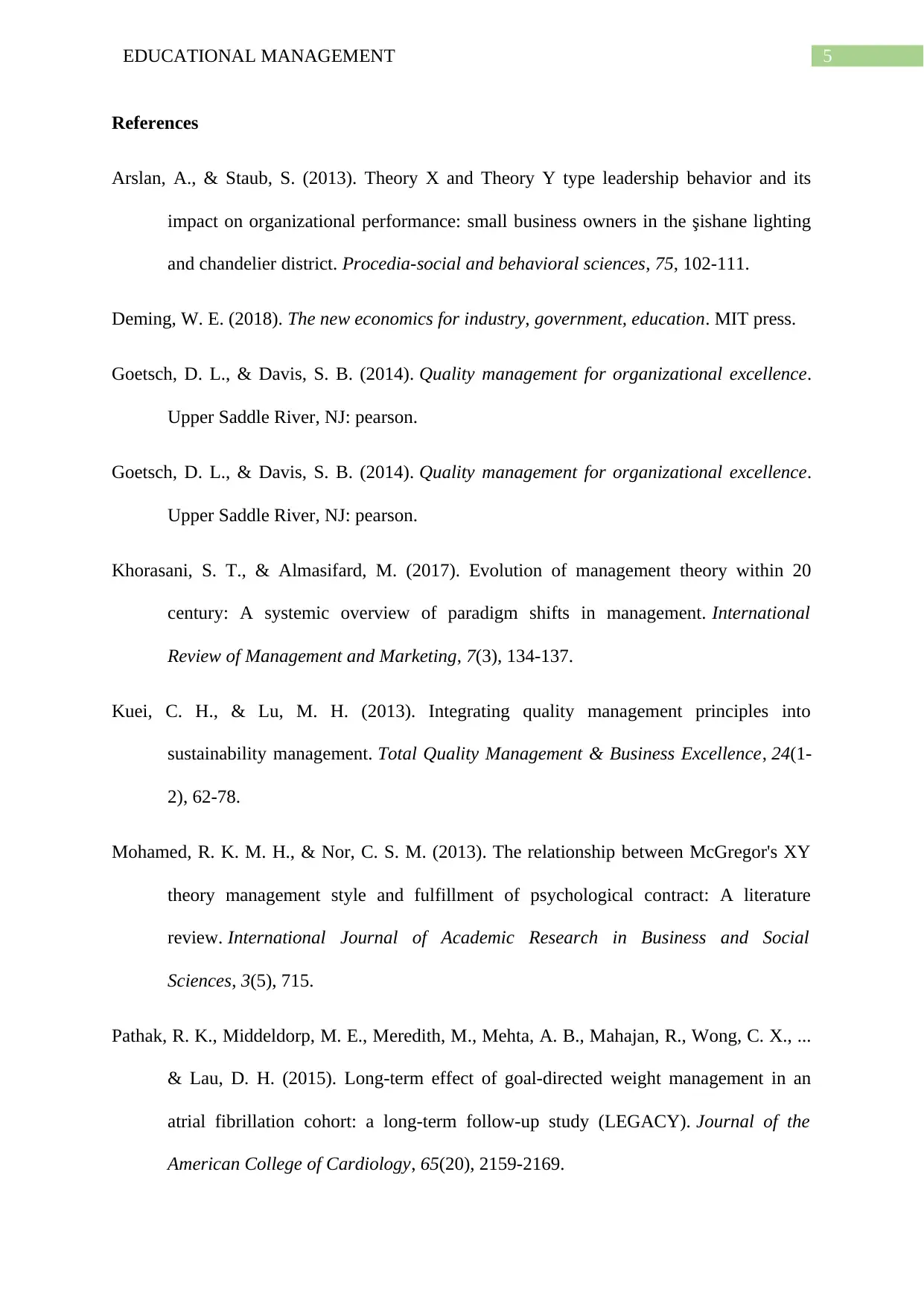
5EDUCATIONAL MANAGEMENT
References
Arslan, A., & Staub, S. (2013). Theory X and Theory Y type leadership behavior and its
impact on organizational performance: small business owners in the şishane lighting
and chandelier district. Procedia-social and behavioral sciences, 75, 102-111.
Deming, W. E. (2018). The new economics for industry, government, education. MIT press.
Goetsch, D. L., & Davis, S. B. (2014). Quality management for organizational excellence.
Upper Saddle River, NJ: pearson.
Goetsch, D. L., & Davis, S. B. (2014). Quality management for organizational excellence.
Upper Saddle River, NJ: pearson.
Khorasani, S. T., & Almasifard, M. (2017). Evolution of management theory within 20
century: A systemic overview of paradigm shifts in management. International
Review of Management and Marketing, 7(3), 134-137.
Kuei, C. H., & Lu, M. H. (2013). Integrating quality management principles into
sustainability management. Total Quality Management & Business Excellence, 24(1-
2), 62-78.
Mohamed, R. K. M. H., & Nor, C. S. M. (2013). The relationship between McGregor's XY
theory management style and fulfillment of psychological contract: A literature
review. International Journal of Academic Research in Business and Social
Sciences, 3(5), 715.
Pathak, R. K., Middeldorp, M. E., Meredith, M., Mehta, A. B., Mahajan, R., Wong, C. X., ...
& Lau, D. H. (2015). Long-term effect of goal-directed weight management in an
atrial fibrillation cohort: a long-term follow-up study (LEGACY). Journal of the
American College of Cardiology, 65(20), 2159-2169.
References
Arslan, A., & Staub, S. (2013). Theory X and Theory Y type leadership behavior and its
impact on organizational performance: small business owners in the şishane lighting
and chandelier district. Procedia-social and behavioral sciences, 75, 102-111.
Deming, W. E. (2018). The new economics for industry, government, education. MIT press.
Goetsch, D. L., & Davis, S. B. (2014). Quality management for organizational excellence.
Upper Saddle River, NJ: pearson.
Goetsch, D. L., & Davis, S. B. (2014). Quality management for organizational excellence.
Upper Saddle River, NJ: pearson.
Khorasani, S. T., & Almasifard, M. (2017). Evolution of management theory within 20
century: A systemic overview of paradigm shifts in management. International
Review of Management and Marketing, 7(3), 134-137.
Kuei, C. H., & Lu, M. H. (2013). Integrating quality management principles into
sustainability management. Total Quality Management & Business Excellence, 24(1-
2), 62-78.
Mohamed, R. K. M. H., & Nor, C. S. M. (2013). The relationship between McGregor's XY
theory management style and fulfillment of psychological contract: A literature
review. International Journal of Academic Research in Business and Social
Sciences, 3(5), 715.
Pathak, R. K., Middeldorp, M. E., Meredith, M., Mehta, A. B., Mahajan, R., Wong, C. X., ...
& Lau, D. H. (2015). Long-term effect of goal-directed weight management in an
atrial fibrillation cohort: a long-term follow-up study (LEGACY). Journal of the
American College of Cardiology, 65(20), 2159-2169.
⊘ This is a preview!⊘
Do you want full access?
Subscribe today to unlock all pages.

Trusted by 1+ million students worldwide
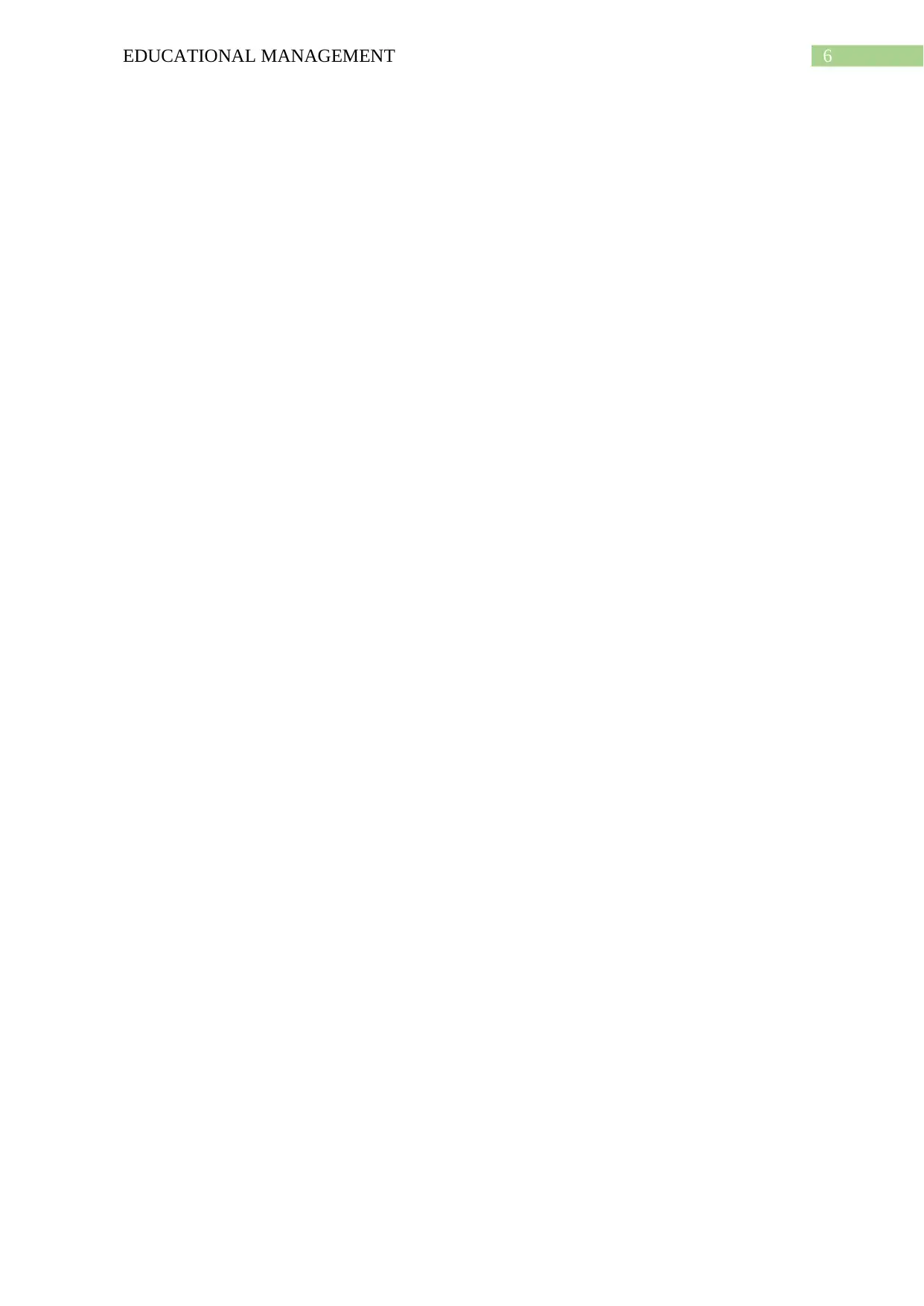
6EDUCATIONAL MANAGEMENT
Paraphrase This Document
Need a fresh take? Get an instant paraphrase of this document with our AI Paraphraser

7EDUCATIONAL MANAGEMENT
1 out of 8
Related Documents
Your All-in-One AI-Powered Toolkit for Academic Success.
+13062052269
info@desklib.com
Available 24*7 on WhatsApp / Email
![[object Object]](/_next/static/media/star-bottom.7253800d.svg)
Unlock your academic potential
Copyright © 2020–2025 A2Z Services. All Rights Reserved. Developed and managed by ZUCOL.





